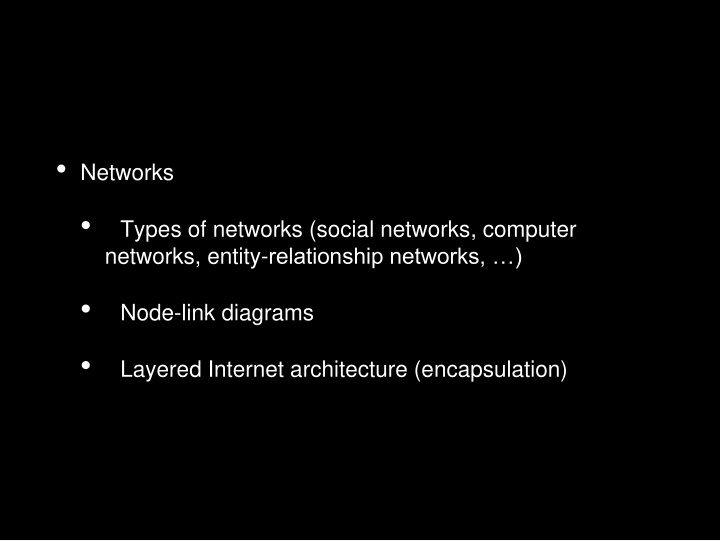



• Networks • Types of networks (social networks, computer networks, entity- relationship networks, …) • Node-link diagrams • Layered Internet architecture (encapsulation)
• The Internet • Structure of the “Internet core” (ISPs, IXP’s, CDN’s) • Packet switching (store and forward, routing) • Types of delays (transmission, propagation, queueing, processing) • Computing throughput • Causes of packet loss (buffer overflow, bit errors, excessive delay) • Traceroute
App Layer
• Service Model • SMTP (message format, interaction) • • Example applications (Web, email, streaming video, …) POP3 (message format, iteraction) • • Client-server architecture Interaction scenario • • Processes 7-bit ASCII limitation • • Socket Programming Sockets • • Port numbers Creating sockets in Python 3 (UDP, TCP) • • Domain Name System Designing an application level protocol • The Web • Application “stacking” (one application layer protocol using another) • HTTP message formats (GET, Conditional GET, HEAD, POST, • DELETE, response) Distributed hierarchical architecture (root servers, TLD servers, authoritative servers) • HTTP interaction • Resource records • Sequence diagrams • DNS message format • HTTP use of TCP (persistent, non-persistent) • Streaming • Cookies • Media coding (audio, video) • Proxy servers • Quality of service requirements (continuous replay, packet loss, • Email latency, adaptation) • • Email architecture (mail servers, “user agents”) Clint-side buffering • • DASH Mail message format
Transport Layer
• Common Transport Pieces • Adaptation (timeout tuning, flow control) • • Overarching skills Socket addressing (UDP, TCP) • • Checksums Timing analysis • UDP • Protocol inspection using Wireshark • • UDP service goals (unordered, unguaranteed “best Understanding how protocol layers work together effort” delivery) • Understanding why protocols differ • Applications that use UDP • Designing new protocols • UDP message format • Protocol implementation • TCP • Understanding the consequences of design • TCP service goals (ordered, guaranteed, eventual decisions (technical, social) delivery) • TCP (Only the following topics, which were not on • Applications that use TCP Exam 1) • • Reliable data transfer (checksums, Flow control acknowledgement, timeouts, pipelining) • Setting the timeout • Reading Finite State Model diagrams • Connection close • TCP message format
Network Layer
• Routers • Fragmentation • • Separation of data and control Network address translation planes • IPv6 • Data plane design (input buffer, • bus switch, output buffer) Tunneling • • Routing Queueing (FIFO, weighted fair queueing) • Routing tables (longest prefix • IP matching) • • Hierarchical IP address space Autonomous systems • • DHCP Shortest path routing • • IPv4 addresses and “Datagram” Border Gateway Protocol (BGP) format
Link Layer
• Point to Point • Physical layer (twisted pair, coaxial cable, fiber, microwave, satellite) • Error detection (CRC) • Error correction • Ethernet • Subnets • CSMA/CD • MAC addresses • ARP • Ethernet frame structure • Switched Ethernet
Wireless
• WiFi • Power management • • Mobile Data CSMA/CA (SIFS, DIFS, RTS, CTS) • 4G architecture • Physical layer issues • (signal strength, multipath, Combination of FDMA interference, hidden and TDMA terminal) • CDMA • Adaptive rate selection • Handoffs • Association (SSID) • Roaming mobility (indirect • 802.11 frame structure routing)
Security
• Hacking • Encryption • • Bots and botnets Symmetric key encryption • • Distributed denial of service attacks Public key encryption • • Ransomware PGP for email • • Social attacks SSL (and TLS) • • Authentication Disinformation • Firewalls • Hash • • Firewalls (stateful, stateless) Message Authentication Codes • • Gateways Digital signatures • • Intrusion detection Man-in-the-middle attacks • Certificate authorities
Social Issues
• Appropriate Use • Twitter • • Legal system (constitution, laws, regulations, treaties) Agile development methods • • Contracts (e.g., terms of service) Adoption of innovation (social structure, social structure, predictors) • Policy (e.g., privacy policies) • Financing • Norms • The Interplanetary Internet • Technical means • Interplanetary propagation delays • Jurisdiction • Interplanetary queueing delays • Controlling collection vs. controlling use • Delay tolerant networking • Balancing interests • Sneakernet • Privacy • Edge caching • FISA Section 702 • Global Internet Access • Upstream collection • Demographic challenges • About collection • Spatial challenges • Multi-communication transactions • Last- mile technology (Fiber, radio, drones, balloons, …) • Context-sensitive design
Recommend
More recommend